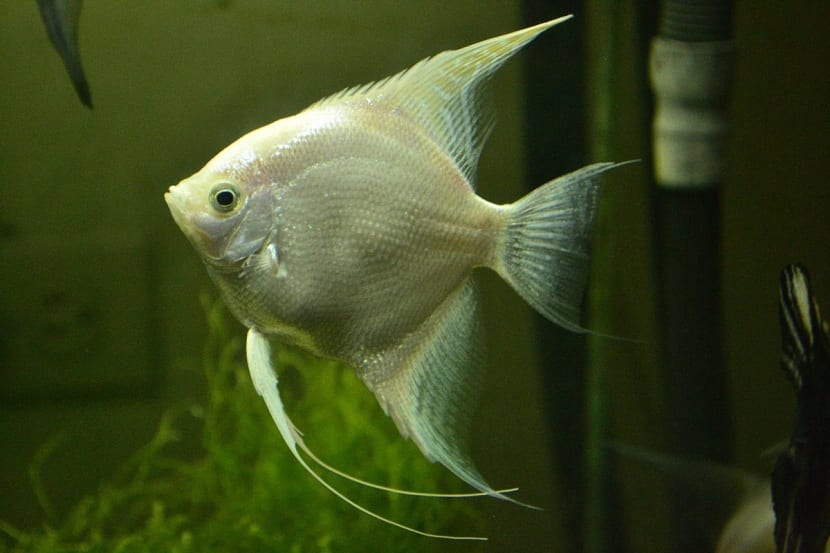
An exotic fish for its beauty and its forms lives in the waters of the rivers of South America. It is a fish that has a great variety of colors and is highly valued by those who like aquariums. Discovered in Brazil in 1823 and belonging to the cichlid family, today we come to talk about angelfish.
If you want to know more about freshwater angelfish, saltwater angelfish, their care, varieties, compatibility and prices, keep reading.
Angelfish characteristics
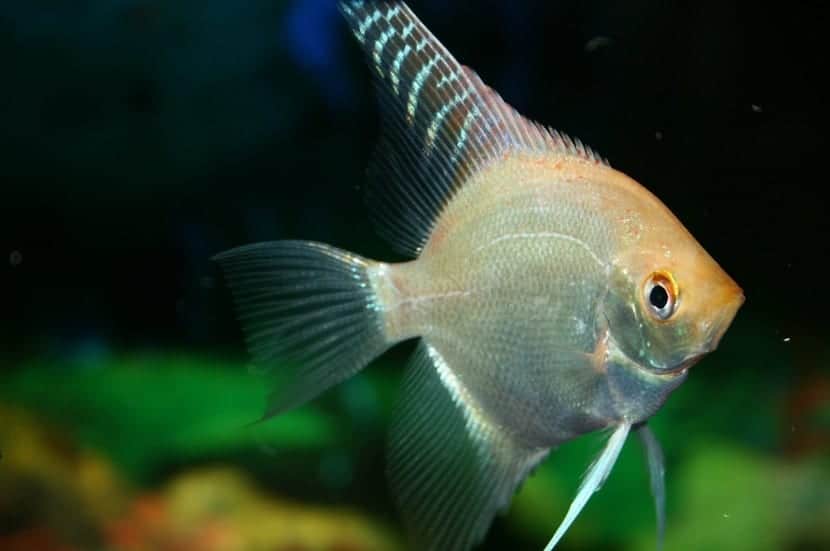
Angelfish inhabit the waters of rivers such as the Amazon and its tributaries. Because the water is rich in large amounts of algae, the morphology of the fish is adapted to be able to swim in these environments. It is characterized by being thin and elongated, being able to move easily through the vegetation without getting caught. When swimming, its body is kept upturned and with the dorsal, pectoral and ventral fins it propels itself. As these fins are quite large, it gives the fish an appearance of being large and dangerous before other species.
Thanks to its shape and colors, it can survive well for about 5-8 years. In total it measures about 15 cm in length. Between the male and the female there is not much difference. The dorsal and anal fins are large and form a triangle in the general appearance of the fish. The caudal fin is also large, and the abdominals have become two long rays of up to 8 cm.
Reproduction of angelfish
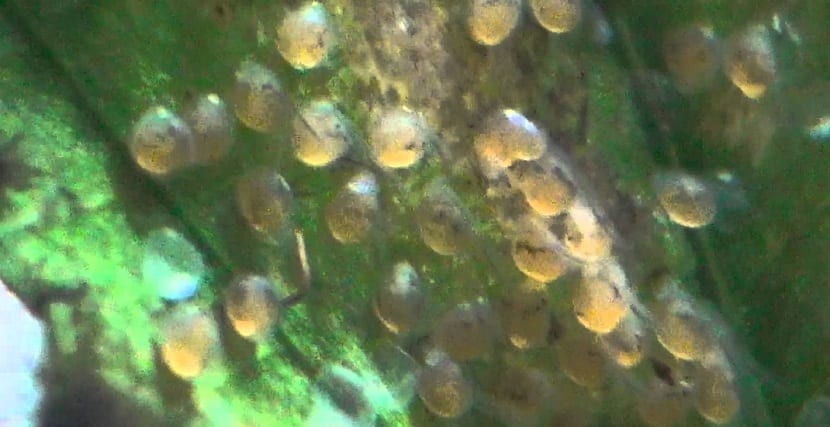
This animal has quite complex behaviors when it comes to reproducing. It is a fairly territorial animal so it is very dedicated to caring for the fry, especially when they are in the initial phase of breeding. They are generally monogamous, although it has been recorded that every few mating cycles, males change partners.
The females choose their males based on aggressiveness and those who appear to have more reproductive experience. Those who are more aggressive are the ones who have the best chance of mating, while the submissive ones are rejected. There is an explanation for this and it lies in the fact that, normally, males that are more aggressive defend their young better. There are studies that determine a greater number of larvae that survive thanks to the fact that the male is more aggressive towards the rest. de peces.
To lay the eggs, the females puts them on plants or rocks, since these present the particularity of being adhesive. To deposit the eggs before spawning, both clean the surface of the plant or rock where they are going to place them. When spawning occurs, the male uses a conduit through which he expels the sperm that is pointed and slightly inclined forward. The female has a slightly longer, thick and rounded oviduct, sloping backwards. They can deposit between 150 and 350 eggs.
Angelfish in the aquarium
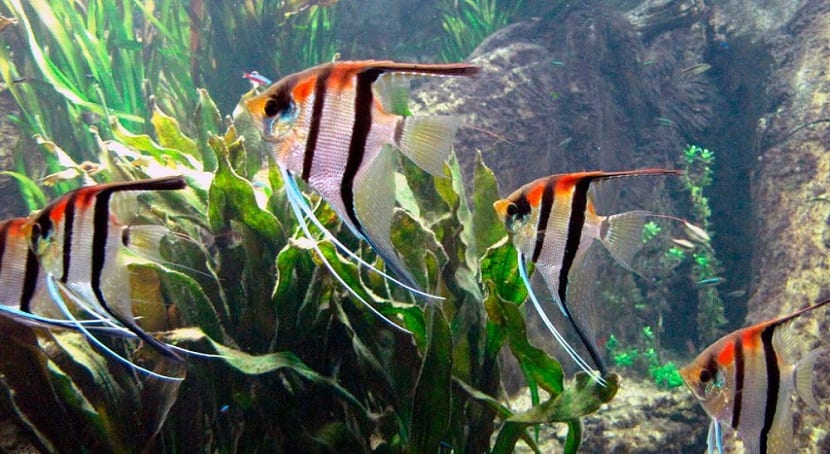
Due to its beauty, shape and colors, the angelfish is in high demand by those who love aquariums. Angelfish live in warm waters of South America, so the temperature of the aquarium must be kept at around 25 ° C. The aquarium must be quite deep, since angelfish like to swim vertically.
Unlike what can be weighed on the territorialism of angelfish, it is very sociable with other species, so we can share the aquarium with other warm-water fish. Yes we must be careful with those fish that we introduce in the aquarium that are small, since angelfish are omnivorous and could take them as food.
As for food, it offers a lot of comfort to be able to use dry food. Live foods produce better spawning in angelfish, so the use of live water fleas is recommended.
If we want to reproduce the angelfish in the aquarium, we must generate better conditions in our aquarium. Once spawning takes place, the fry pair should be separated during the first week of life. To take care of the fry, we must transfer them to a fish tank, but keep the same water with which they were born, in which we will place some methylene blue drops that prevents the spread of fungi.
Saltwater angelfish
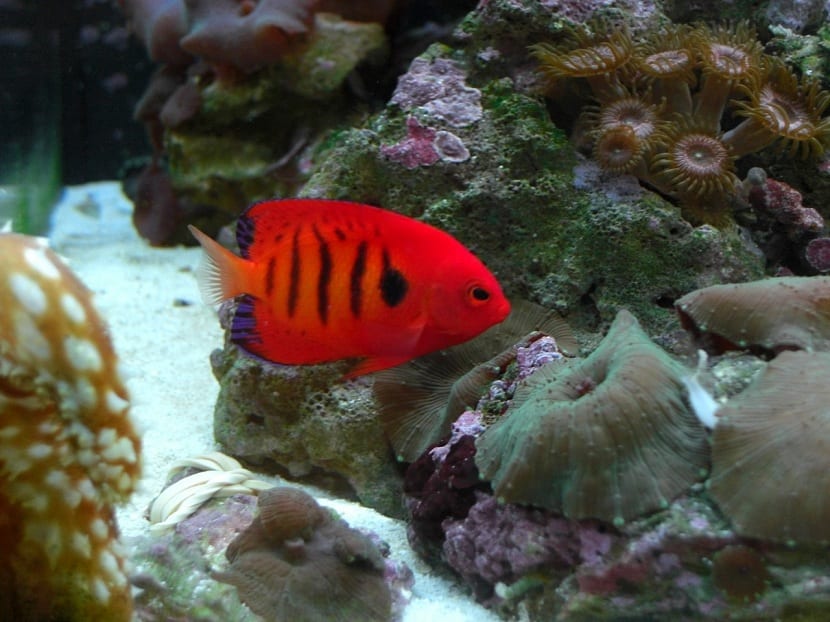
Saltwater angelfish are just as showy and colorful as freshwater angelfish. These fish have solid spines on their preopercules that are found in the lower section of both gill covers.
They belong to the family pomacanthidae. Due to their spines it is very normal for them to get hooked in aquarium fish nets. To avoid this, when you are caught, you have to guide in a transparent plastic container and lift it up to remove it from the aquarium.
Generally, saltwater angelfish inhabit the shallow tropical reefs of the Atlantic, Indian and Western Pacific Oceans. They are 8-10 cm in size and some species can keep well in aquariums with a capacity of 5,7 liters of water. They normally adapt very well to aquarium life and accept various types of frozen food.
To fully enjoy your saltwater angelfish, the aquarium needs to have:
- Reef quality water and strong movement
- Living rocks and caves
- Hardy corals
- An efficient protein harvester
- A quality saltwater mix suitable for reefs
- A program of periodic partial water changes
- A careful eating regimen
Emperor angelfish
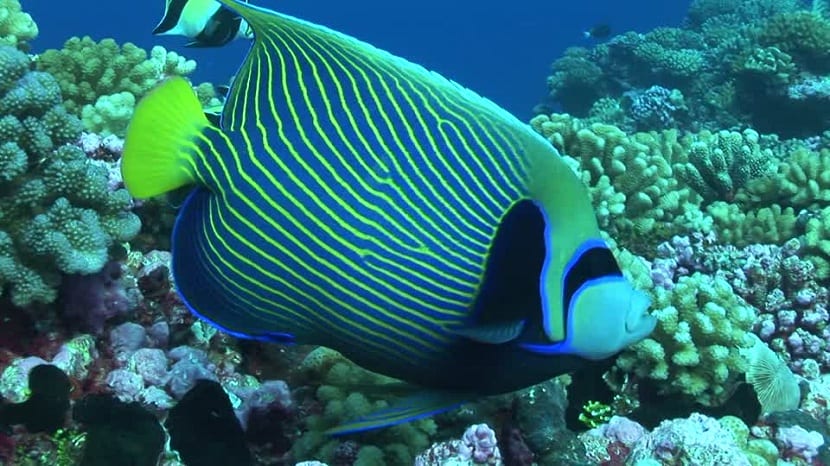
Emperor angelfish is a solitary species that is well suited to aquariums. If the conditions in which they live are good, they can reach up to ten years of age. It can be maintained both alone and as a couple, since when it reaches maturity becomes intransigent with the rest de peces.
Angelfish present the peculiarity of appearing to have a total change in their coloration, which at first caused many of the species of this genus to be cataloged with two names, one related to their juvenile phase and the other to their adult phase. During the juvenile phase it has a navy blue and black coloration with white and navy blue circles with different sizes. However, when it reaches adulthood it presents a blue coloration with fine diagonal yellow lines. The color change occurs gradually when the animals reach a size of 8 cm.
Your ideal aquarium size is about two meters in length and a depth of 50 cm or greater. About 300 liters of water and if you want to keep a couple, it would have to be about 500 liters. The water has to have a pH between 8,1 and 8,3 and salinity between 1.022 and 1.024 Kh. Similar temperatures to those found on reefs, between 24 and 26 ° C.
Queen angelfish
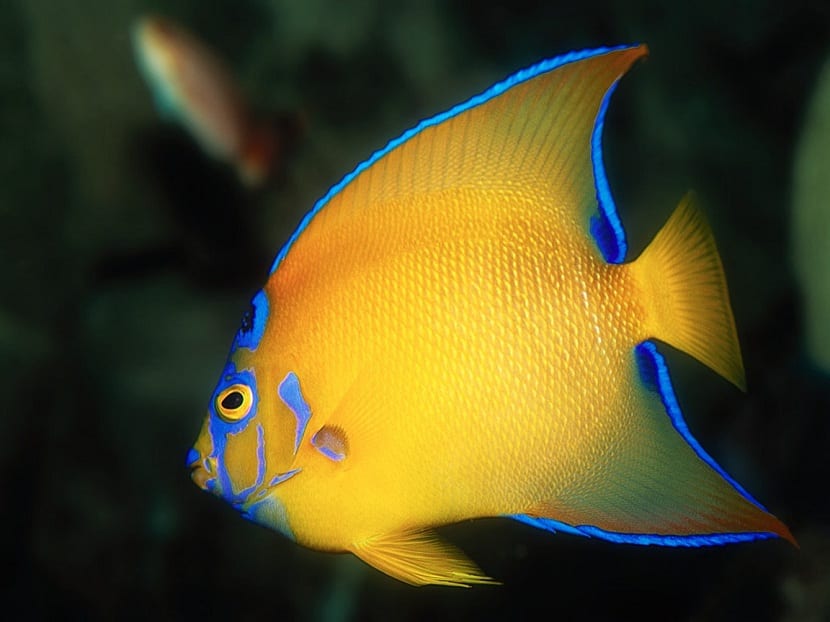
This fish also belongs to the family pomacanthidae. Inhabits coral reefs at depths of between 1 and 70 meters. It has a triangular-shaped head and a rectangular-shaped body. It has a total of 14 hard spines and 19 to 21 soft rays and a coloration divided into: the mouth is yellow or orange, the back of the head has an almost black stripe, the lower part is yellow-orange and the rest of the body of blue-greenish color.
Regarding the conditions that they have to have in the aquarium we have:
- Temperatures of 25-30 ° C
- pH 8,2-8,4
- Salinity 1.023-1.027
- 500 liter capacity aquarium
- Food based on frozen, granulated, flakes, shrimp etc. although in the long term we will have to supply sponges that are the basis of your diet.
It must be taken into account when having it in the aquarium that is aggressive with his own species or those that have bodily similarities.
Flame Angelfish

This fish also belongs to the family pomacanthidae. It is known as flame angelfish or flame angelfish for being one of the most striking. Its coloration is deep red and has vertical black lines with an electric blue trim on the back of its dorsal and anal alerts.
Regarding the conditions that must be kept in the aquarium for optimal conditions, we have:
- Salinities of 1.023
- Temperatures between 24 and 28 ° C
- Frozen foods and some vegetable supplements
Some problems that the llama angelfish can present are adaptation with the rest de peces aquarium. If these fish begin to become stressed, parasites such as the marine white spot will begin to appear. To avoid this, we must put enough live rock in the aquarium so that it sits safely and has ground to peck and hide.
Lastly, the prices of all varieties of angelfish vary. between 35 and 400 euros. Each price will depend on the age, quality, color, beauty, etc.
With this information you can keep your fish healthy and have your fish tank with a color like never before seen. You just have to follow the conditions well so that the fish is as comfortable as possible and does not have problems with the rest. de peces that is in the aquarium.
HELLO:
I have a for de peces angel in my aquarium (just the two of them), marble black, for some time now I have noticed a lot of aggression between them, do you have any idea why this behavior?
Very good wilmer, if the angelfish is a bit aggressive even when it can share a fish tank but maybe your fish are males, I recommend you both and find out how to distinguish them, greetings